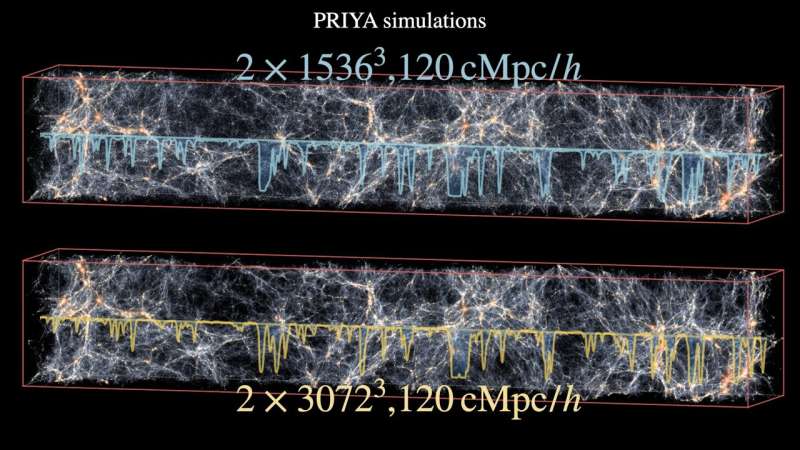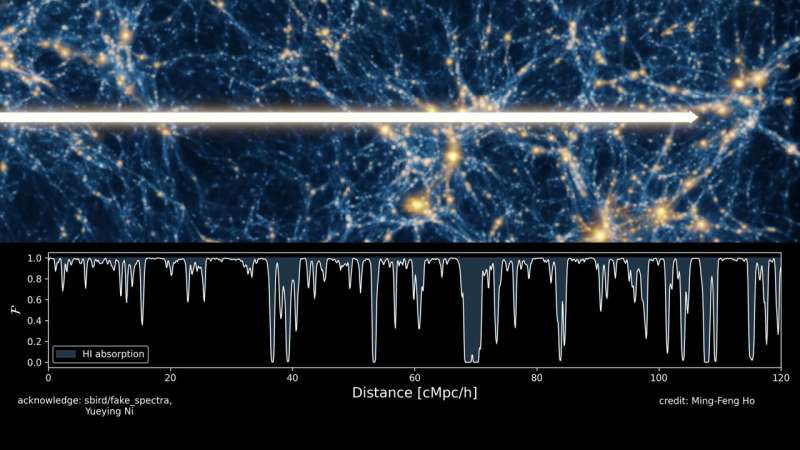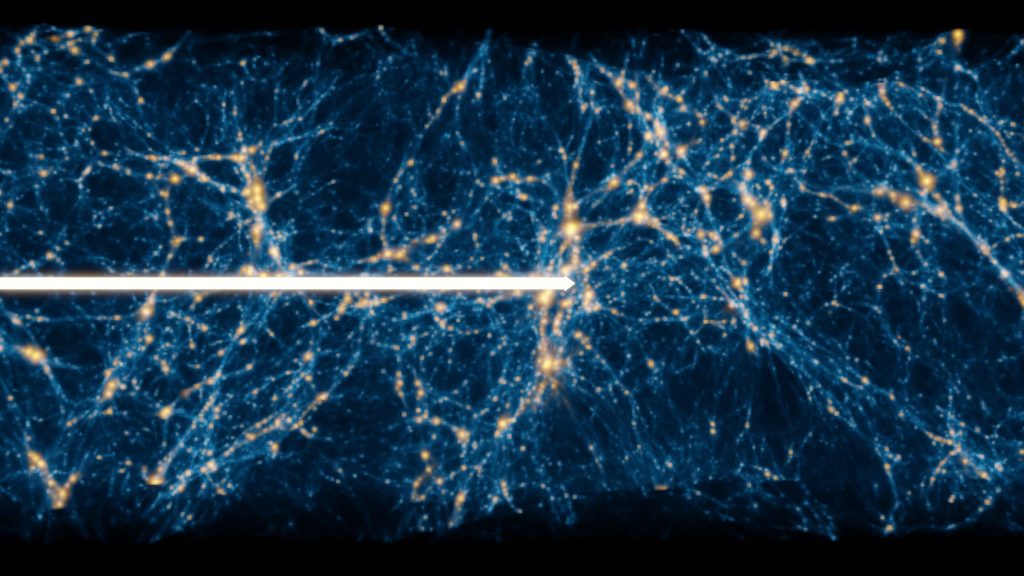Artistic reconstruction of a photon’s path through intergalactic gas. Courtesy of University of California, Riverside
The dense peaks of the wavelength distribution graph observed in a Lyman Alpha forest do indeed resemble many small trees. Each of these peaks represents a sharp drop in “light” at a specific narrow wavelength, effectively mapping the materials that the light has encountered on its way to us.
This is similar to shadow play, where we infer a person’s identity from their silhouette between the light and the screen. The “shadows” of hydrogen molecules that float far away between us and the light emitted by a powerful source even further away are well recognized by astrophysicists.
The image used is called a spectrogram: it breaks down radiation (which we’ll call light for simplicity’s sake, but which also includes invisible frequencies) into its constituent wavelength bands.
“It’s kind of like a very detailed rainbow,” explains Simeon Bird, a physicist at the University of California, Riverside, and one of the study’s authors.
A rainbow is seen when sunlight passes through a prism (or a drop of water) and is split into its “components,” with the mixed wavelengths emerging as white light.
The same thing happens in spectrograms of light coming from cosmic sources like quasars, but in most cases some frequencies are missing, appearing as black bands where no light is present, as if something had cast a shadow: these are atoms and molecules that the light encountered along the way.
Each type of atom has a particular way of absorbing light, leaving a kind of signature on the spectrogram, making it possible to track their presence, especially that of hydrogen, the most abundant element in the universe.

PRIYA simulation example. Courtesy of University of California, Riverside.
“Hydrogen is Dark matter“Dark matter is one of the great challenges in the study of the universe right now,” explains Bird. “We don’t yet know what it is, and we’ve never seen it, but we do know that it’s there in greater abundance than regular matter.”
Bird and his colleagues used hydrogen to indirectly track dark matter: “It’s like putting a dye into flowing water, and the dye follows the direction of the water flow. Dark matter moves with gravity, so it has a gravitational potential. Hydrogen gas falls into it, and we use that as a tracer for dark matter. Where there is more density, there is more dark matter. You can think of the hydrogen as the dye and the dark matter as the water.”
Byrd and his colleagues’ work goes beyond monitoring dark matter: Current cosmology also faces several so-called “tension” problems, or discrepancies, between observations and theoretical predictions.
It’s like opening a can of peeled tomatoes and finding a glass marble inside. Based on your assumptions about how the world works, you expect one thing, but to your surprise, the facts contradict it. Your common sense is the equivalent of a theoretical model in physics; it leads to predictions about the contents, but when you look inside the can, you’re shocked.

PRIYA simulation example. Courtesy of University of California, Riverside.
Two things can happen. Vision problems And they are indeed tomatoes, or your knowledge base is incorrect (perhaps you were in a foreign country and misread the label on the can).
Something similar is happening in astrophysics research: “One of the problems right now is the number of small, low-redshift galaxies,” explains Bird, the universe that is relatively close to us.
“There are two current hypotheses to explain the discrepancy between observations and predictions: either there is a particle we’ve never seen before that we know nothing about, or something strange is going on. Supermassive black hole “It’s inside the galaxy. The black hole is somehow preventing the galaxy from growing, which is messing up our structure calculations.”
Bird and his colleagues’ work confirmed the validity of tension (so they are indeed marbles and not tomatoes), but it also did a bit more.
“The significance of this detection is still fairly small, so it’s not entirely convincing yet. But if this holds up in later datasets, New particles Or maybe it’s not black holes messing up the calculations, but rather there’s some new type of physics at work,” Bird concludes.
The survey results are Published In Journal of Cosmology and Astroparticle Physics.
For more information:
MA Fernandez et al., Cosmological constraints from eBOSS Lyman-alpha forests using the PRIYA simulation, Journal of Cosmology and Astroparticle Physics (2024). Posted on: 2024/07/029
Provided by
International School of Advanced Studies (SISSA)
Quote: Dark matter seen through the forest: Study examines distribution of matter, corroborates unknown effects or new particles (July 29, 2024) Retrieved July 29, 2024 from https://phys.org/news/2024-07-dark-forest-unknown-particle.html
This document is subject to copyright. It may not be reproduced without written permission, except for fair dealing for the purposes of personal study or research. The content is provided for informational purposes only.


